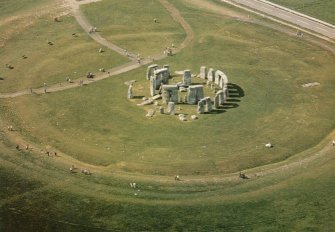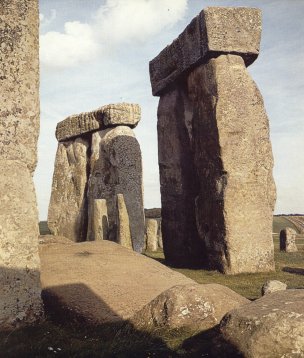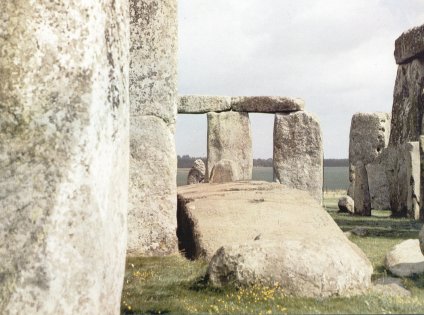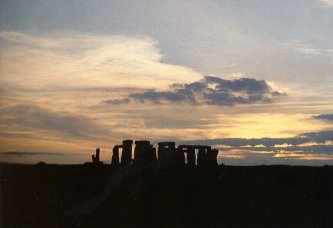 Brief History and Pictures
Brief History and Pictures
| Stonehenge
is one of the most famous prehistoric monuments of Britain. Stonehenge
stands on the southern part of Salisbury Plain, about 8 miles north of
Salisbury. It is the focal point of the densest concentration of Neolithic
and Bronze Age monuments anywhere in Britain. Thanks to the use of radiocarbon
analyses we know that Stonehenge was in use from about 2800 BC until after
1100 BC. Excavations have shown that four main periods can be recognised
in the building and use of Stonehenge, the third of which can be further
divided into three stages: Stonehenge I, II, IIIa,
IIIb,
IIIc
and IV. |

Aerial
view of Stonehenge
|
| |
|

Two
of the trilithons, showing
the
downward taper and curvature
of
the lintels
|
Stonehenge
I seems to have remained in use as a place of Neolithic worship and
burial for about 7 centuries. From period II, it seems that the
users of Stonehenge were concerned to mark certain significant astronomical
directions. The builders of Stonehenge II were probably Beaker people
who brought about two practicesthat gradually transformed the life of the
native Neolithic population: working copper and gold for tools, weapons
and ornaments and the burial of the dead singly instead of communally.
The building of Stonehenge
IIIa began about 2000 BC and probably took many years to complete.
Subsequent alterations were made and excavations have shown that the position
of the stones may have marked the direction of midsummer sunrise in period
IIIb.
At about 1550 BC, close
to the end of the Early Bronze Age, the disposition of the stones was re-arranged
and the final reconstruction brought to an end the long building of Stonehenge. |
| |
|

This
is the best preserved part of the sarsen circle.
The
entrance was beneath the three lintels
|
| |
We cannot be sure how long
it continued as a place of worship, but it must have been for at least
500 years. In period IV, about 1100 BC some changes and additions
were made, which must mean that Stonehenge was still at use at that date.
The later history of Stonehenge
is one of ruin and decay. Most of its stones are now missing. We shall
never know what religious beliefs Stonehenge represents or what forms of
worship or ceremonies took place there. In recent years many suggestions
have been made about the possible use of Stonehenge as an astronomical
observatory, to record the movements of the rising and setting sun and
moon and to predict eclipses. However, since the monument is now so ruined,
the can be no certainty about it. |
| |

View
along the astronomical axis of Stonehenge,
towards
the point of midsummer sunrise
|
| |
|
![]()

![]()
